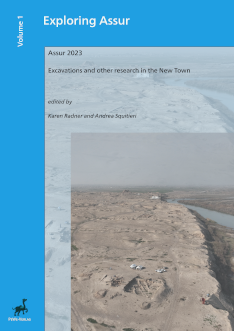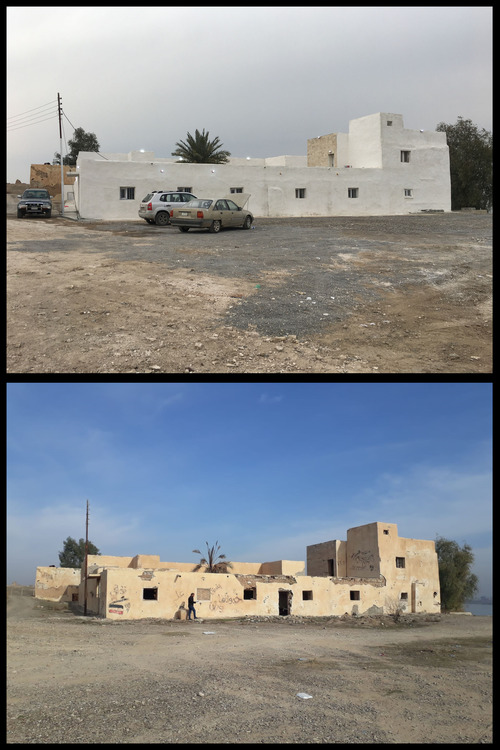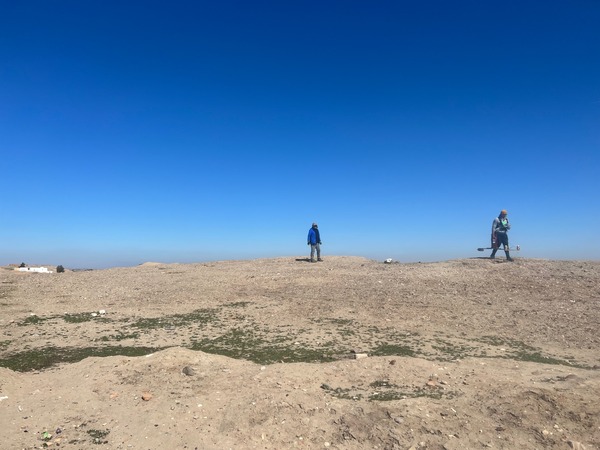New Archaeological Exploration of Assur
Led by Prof. Dr. Karen Radner
ASSUR EXCAVATION PROJECT PUBLICATIONS
 Assur 2023: Excavations and other research in the New Town
Assur 2023: Excavations and other research in the New Town
Karen Radner & Andrea Squitieri (eds.), Assur 2023: Excavations and Other Research in the New Town. Exploring Assur 1. Gladbeck: PeWe-Verlag, 2024.
ISBN 978-3-935012-66-9
Download the Open Access Version here.
Order from PeWe-Verlag here.
Facing north, the location of the 2023 excavations in the New Town of Assur, with the white excavation house and the ziggurat of the Aššur temple visible in the back. Drone image by Jens Rohde.
In April 2022, the Iraqi State Board of Antiquities and Heritage granted permission to a Leibniz Award-funded research project with the title “Excavations and Geophysical Exploration in Assur as well as Restoration of the Andrae House”, jointly headed by Karen Radner and Prof. Dr F. Janoscha Kreppner (WWU Münster). The work plan consists of three parts:
- Restoration of the excavation house of Walter Andrae, severely damaged in late 2016 as the result of ISIS occupation and its capture through Iraqi state forces;
- Geophysical prospection of Assur by means of magnetometer and electrical resistivity tomography (ERT);
- Archaeological excavations focused on the southern extension of the city (“New Town”).
(1) Restoration of the excavation house constructed by Walter Andrae
As part of the excavations of the Deutsche Orient-Gesellschaft in Assur headed by Walter Andrae, the construction of the house started on August 14, 1903, and continued for a year. Andrae built the northern wing of the house, including the Great Hall. When the German mission had to leave at the onset of World War I in 1914, the Ottoman police authority took over the building as their local headquarters (qishla). It served in that function until 1920, and afterwards became the administrative centre of Sherqat district. Once the district headquarters were moved to the town centre in 1929, the Andrae House stood empty and gradually decayed, with most of its ceilings and walls collapsing.
In 1978, the State Board of Antiquities and Heritage (SBAH) of Iraq initiated a project to resume research in Assur. The Andrae House was renovated and enlarged by constructing the southern wing in order to serve as a base for all local and foreign missions working at Assur. It also became the headquarters of the Sherqat SBAH office and continued to serve as such until 2008 when a new building was constructed outside of the city wall, close to the entrance to the archaeological site.
In 2015, an ISIS terrorist cell occupied the Andrae House and used it as military barracks to operate in the Sherqat region. When the Iraqi armed forces attacked late in 2016, the terrorists stripped the building of everything of value, including all furniture, doors, windows, electricity cables and water pipes, and smeared the walls with offensive and obscene graffiti. The recapture of the house resulted in severe damage to the Great Hall’s roof and the destruction of one of the palm trees in the courtyard.
The shell of the building stood empty until September 2022, when the restoration of the Andrae House was initiated by Karen Radner in close collaboration with the Sherqat SBAH office headed by Salim Abdallah, drawing on the restoration expertise of Kamal Rasheed Raheem and Akam Omar Ahmed Al-Qaradaghi. With the work completed in January 2023, the Andrae House served as the base of new LMU-WWU excavations in the first campaign in February and March 2023.
For financing the photovoltaic system, which has been supplying the excavation house with solar power since August 2023, we would like to thank the Bavarian State Ministry for Science and Art, represented by Minister of State Markus Blume, and the Austrian Embassy in Baghdad, represented by its charge d'affaires ad interim, Dr. Andrea Nasi, for their quick and effective help.

The Andrae House before and after renovation. Photos by Akam Omar Ahmed Al-Qaradaghi.
(2) Geophysical prospection of Assur
A LMU team headed by Prof. Dr. Jörg Fassbinder has resumed the magnetometer prospection of Assur, which was inaugurated in 1989, for the first time in Iraq, under the direction of Prof. Dr. Barthel Hrouda (LMU Munich / Bavarian Academy of Sciences and Humanities) and which came to a premature end because of the outbreak of the first Gulf War. The geophysical work at that time was conducted by Dr. Helmut Becker and Jörg Fassbinder (both Bayerisches Landesamt für Denkmalpflege, Munich), who surveyed two hectares in the residential area of Assur.
In February 2023, Fassbinder continued this work with the support of Jean-Jacques Herr, Lena Ruider and Marco Wolf, by embarking on a targeted programme of magnetometer and electric resistivity tomography (ERT) prospection. During ten days of intensive fieldwork, we conducted a large-scale and high-resolution magnetometer survey of the entire area of the New Town of Assur (ca. 250 x 500 m) as well as further parts of the city's residential area. The supplementary ERT measurements provided details on the depth of selected archaeological features.

Jörg Fassbinder and Marco Wolf during the magnetometer prospection, with the Andrae House visible in the back (left-hand side). Photo by Karen Radner.


